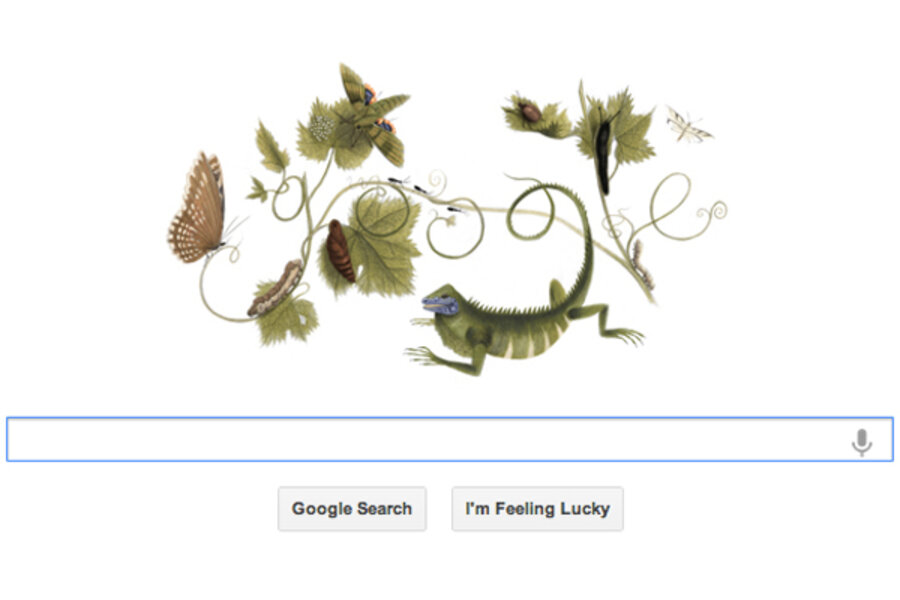How Maria Sibylla Merian opened our eyes to nature
Loading...
In many ways, the artist and naturalist Maria Sibylla Merian, celebrated by Google Tuesday on her 366th birthday, fell victim to her own artistic talent. Ms. Merian's drawings, engravings, and paintings were so good that most people ended up ignoring the extraordinary observations that accompanied them.
A flair for the visual ran in her family. Born in Frankfurt am Main in 1647 to a patrician family of engravers, Merian began drawing and painting at an early age, eventually marrying the still-life painter Johann Andreas Graff. The two moved to Nuremberg, where Merian created embroidery designs and gave drawing lessons to young women from wealthy families. While in Nuremberg, she published three volumes of decorative drawings of flowers, designed for use by embroiderers, cabinetmakers, and other artisans.
But making pictures wasn't Merian's only passion. By the age of 13, she was already raising caterpillars, carefully noting their diets, their behaviors, and the timing of their metamorphoses.
In her thirties, she published two books of engravings of moths, butterflies, and their caterpillars, with accompanying descriptions. Then, in her fifties, she traveled with her daughter to Dutch Suriname to study insects there, in 1705 publishing "Metamorphosis insectorum surinamensium," a collection of 60 engravings, each showing a tropical insect in its full life cycle along with the native plant on which it lived. The work is widely regarded as her masterpiece.
All along the way, Merian racked up a series of remarkable firsts. She was the first European naturalist – male or female – to undertake an independently financed expedition to the New World. She was arguably the first naturalist trained in the fine arts to study a specific type of organism for a sustained period, and one of the first to depict tropical species in their natural colors.
As Gettysburg College biologist Kay Etheridge argues in a 2011 article, she may have been the world's first ecologist, that is, the first person to document the interactions between different species, emphasizing what we would today call the food chain. You could even make the case that she was the first female biologist of the modern era.
Indeed, Merian was a member of one of the first generations in the West to take seriously the concept of empirical observation. It was only during her lifetime that a consensus among scholars began forming around the concepts of experimentation, repeatability, and peer review. As Los Angeles Times art critic Holly Myers noted in a 2008 review of a Merian exhibition at the Getty Museum, her era was one of upheaval "which saw science, religion and art locked in a state of muddled and sometimes violent agitation."
Ms. Myers notes that "Descartes published his 'Discourse on the Method' ('I think, therefore I am') in 1637, a decade before Merian's birth. The Protestant Reformation came to a close in 1648, a year after she was born. Isaac Newton was only a few years Merian's senior and published the "Philosophiae Naturalis Principia Mathematica," outlining his three universal laws of motion, in 1687."
But Merian also lived era of widespread superstition. In 1663, the mayor of Magdeburg, Germany, devoted himself to assembling a unicorn skeleton. A year later, Pope Alexander VII reiterated the Church's ban on books that claimed the earth orbited the sun (a proscription that would remain in some form until 1822). As Merian was peering at caterpillars in Nuremberg, other cities were burning women for witchcraft.
Later naturalists largely overlooked Merian's scientific acumen, with some dismissing her observations as fantastical. In a 2010 paper, Ms. Etheridge quotes the Reverend Lansdown Guilding, an early 19th century naturalist who specialized in the flora and fauna of the Caribbean. Mr. Guilding called Merian's description of the fauna that lives on guava trees – including spiders that capture hummingbirds in their webs and ants that build bridges out of themselves – as "entomological caricature." Of course, today we know that these observations were spot on.
But it may have also been the sheer beauty of Merian's artwork – Russian tsar Peter the Great was among its admirers – that ultimately overshadowed her contributions to entomology. Even today, the full text of the observations accompanying her images is hard to come by in English.
"Ironically," writes Etheridge, "it may be that the focus on Merian’s consummate artistry has diverted attention from the scientific content of both her images and text, and has been a factor in her being overlooked as a significant early modern naturalist."
But for Merian, science and artistry were inextricably bound. Myers of the The LA Times was taken by a quote by Merian displayed on one of the walls at the Getty exhibition: "Art and nature shall always be wrestling until they eventually conquer one another so that the victory is the same stroke and line: that which is conquered, conquers at the same time."
Merian clearly embodied this synthesis, and perhaps it can occur for all of us who love the natural world, as long as we follow her example and remember to keep our eyes open, appreciate the small things, and, most of all, never underestimate girls who collect caterpillars.








